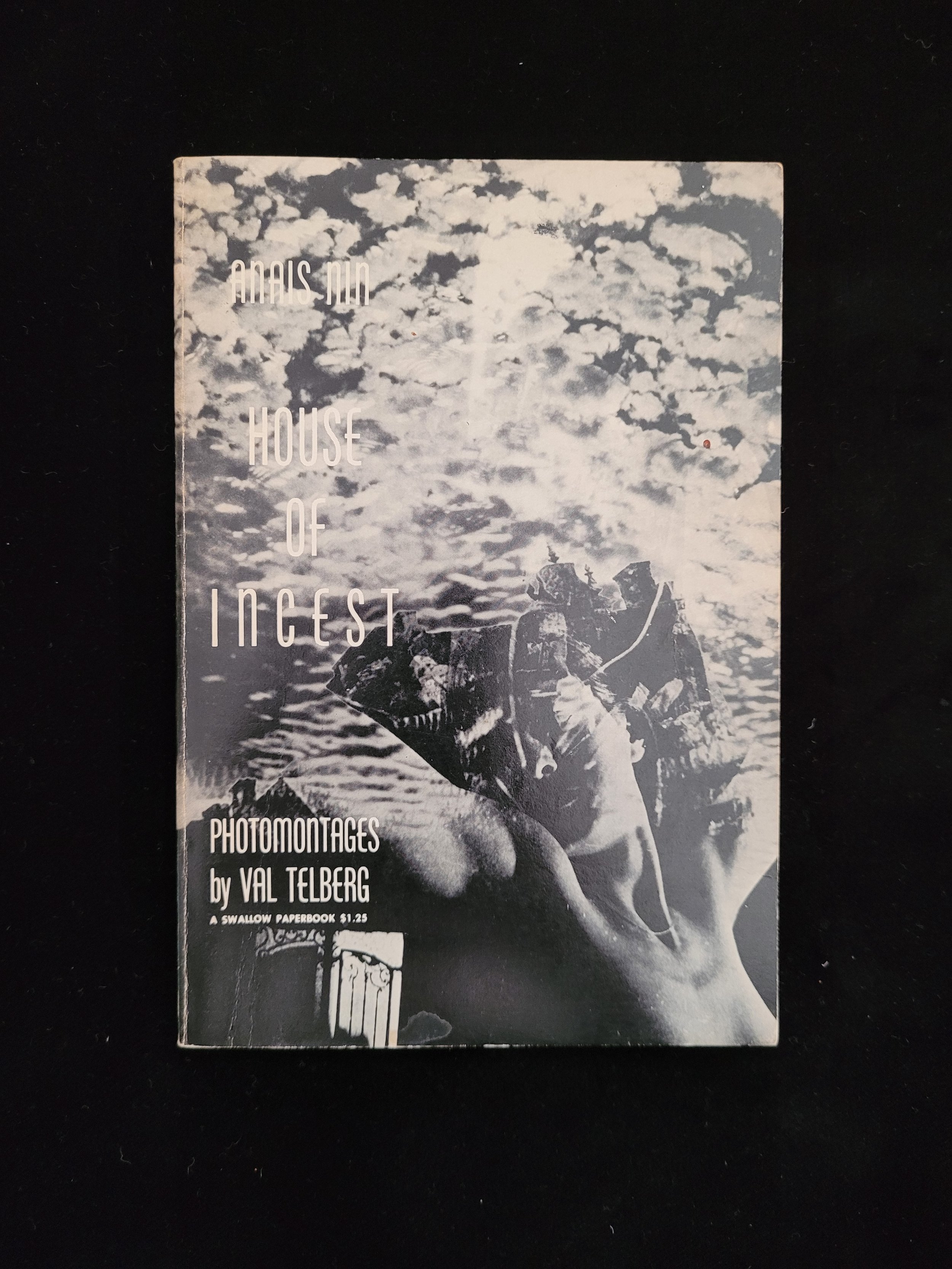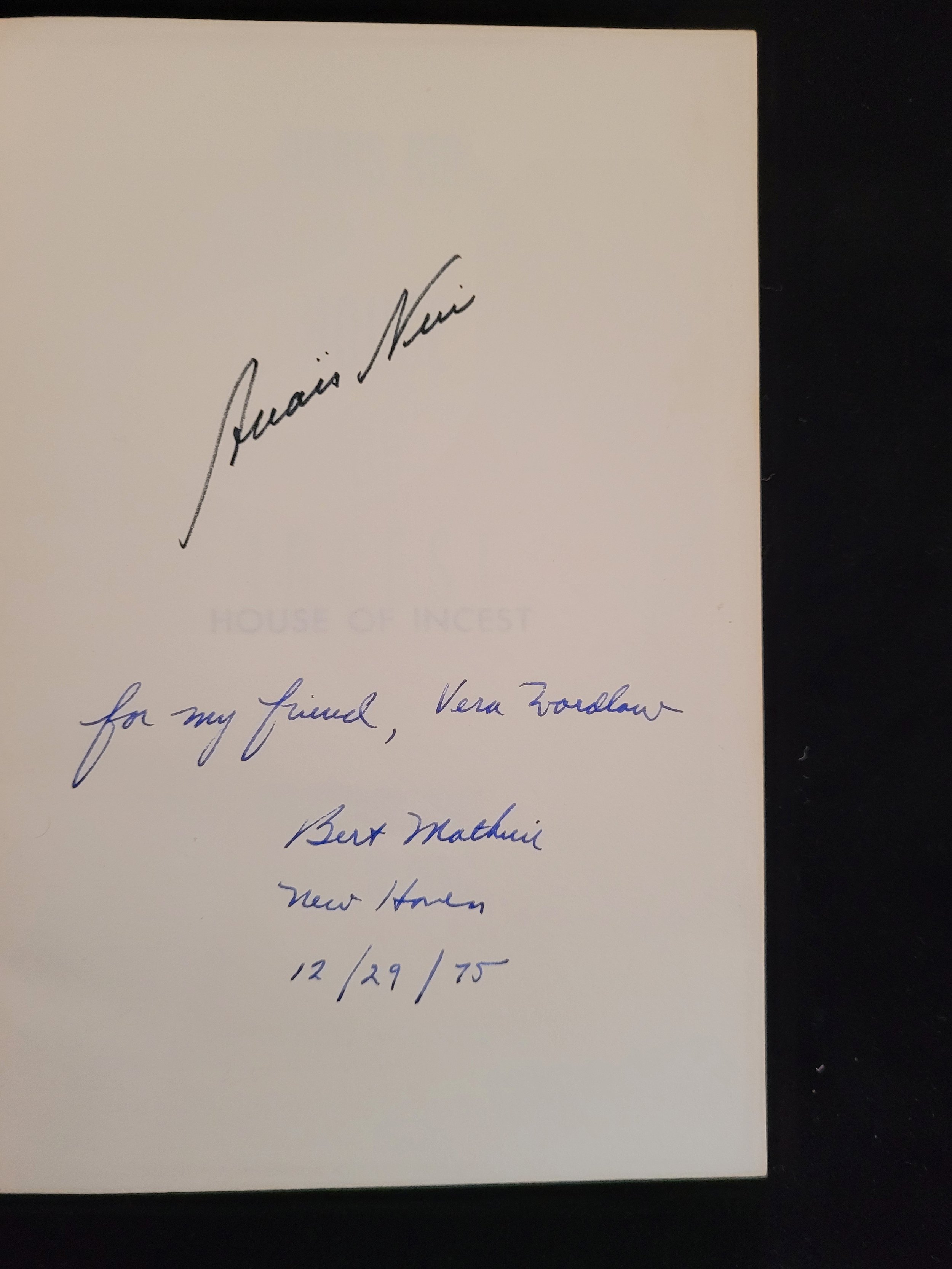 Image 1 of 2
Image 1 of 2

 Image 2 of 2
Image 2 of 2



House of Incest
NIN, Anaïs
House of Incest
Chicago: The Swallow Press Inc., 1958
8vo., black and white printed wraps by the Swallow Press; with ads for other Nin titles to the lower cover; pp. [xii], 15-72, [ii]; with 9 black and white photographic illustrations (including one double page); a little rubbed at edges; binding string visible at inside rear cover; small white paint mark to lower cover; pages evenly toned. Provenance: Early 21st century ex libris to inside front cover.
First trade paperback edition signed by Nin to the ffep and further inscribed to Vera ?Woodlow and dated 29th December 1975.
House of Incest first appeared in 1936 in Paris, under Nin's own Siana imprint, and was re-published in 1947 by her Gemor Press in New York. Nin's second published book, it was a work of poetic prose akin to chamber music in three parts, which her analyst and lover Otto Rank helped her edit. The first 1936 edition was published using money provided by Michael Fraenkel. It was one of a series of smaller publications issued by her circle around this time, including Henry Miller’s Scenario (based on Nin’s work), and What Are You Going to do About Alf? Modern readers will jump to the conclusion that the book has something to do with an incestuous relationship with her father Joaquin, but the incest is not physical or sexual and has nothing directly to do with her father. The incest refers to a form of narcissism explored by Otto Rank in which one can only love in another what reflects or completes oneself. It is summed up in Nin’s phrase: “If only we could all escape from this house of incest, where we only love ourselves in the other.” Although there are echoes of her father and June Mansfield (Henry Miller's wife, the subject of Henry and June) in this work, there is, again, no suggestion of sexual incest, but rather the realisation of the fact that she can only love, accept and identify in the other that which reflects herself and answers her own needs.
Nin’s father, the musician Joaquin Nin, may be symbolised in this book by Lot, named after the Biblical father. The description is part of a fantasy, not an echo of a real-life event. “Stumbling from room to room I came into the room of paintings, and there sat Lot with his hand upon his daughter's breast while the city burned behind them, cracking open and falling into the sea.”
Various passages in the book echo Nin’s own feelings: “I am enmeshed in my lies, and I want absolution…the truth would be death-dealing, and I prefer fairytales. I am wrapped in lies which do not penetrate my soul. All the lies I told were like costumes.”
NIN, Anaïs
House of Incest
Chicago: The Swallow Press Inc., 1958
8vo., black and white printed wraps by the Swallow Press; with ads for other Nin titles to the lower cover; pp. [xii], 15-72, [ii]; with 9 black and white photographic illustrations (including one double page); a little rubbed at edges; binding string visible at inside rear cover; small white paint mark to lower cover; pages evenly toned. Provenance: Early 21st century ex libris to inside front cover.
First trade paperback edition signed by Nin to the ffep and further inscribed to Vera ?Woodlow and dated 29th December 1975.
House of Incest first appeared in 1936 in Paris, under Nin's own Siana imprint, and was re-published in 1947 by her Gemor Press in New York. Nin's second published book, it was a work of poetic prose akin to chamber music in three parts, which her analyst and lover Otto Rank helped her edit. The first 1936 edition was published using money provided by Michael Fraenkel. It was one of a series of smaller publications issued by her circle around this time, including Henry Miller’s Scenario (based on Nin’s work), and What Are You Going to do About Alf? Modern readers will jump to the conclusion that the book has something to do with an incestuous relationship with her father Joaquin, but the incest is not physical or sexual and has nothing directly to do with her father. The incest refers to a form of narcissism explored by Otto Rank in which one can only love in another what reflects or completes oneself. It is summed up in Nin’s phrase: “If only we could all escape from this house of incest, where we only love ourselves in the other.” Although there are echoes of her father and June Mansfield (Henry Miller's wife, the subject of Henry and June) in this work, there is, again, no suggestion of sexual incest, but rather the realisation of the fact that she can only love, accept and identify in the other that which reflects herself and answers her own needs.
Nin’s father, the musician Joaquin Nin, may be symbolised in this book by Lot, named after the Biblical father. The description is part of a fantasy, not an echo of a real-life event. “Stumbling from room to room I came into the room of paintings, and there sat Lot with his hand upon his daughter's breast while the city burned behind them, cracking open and falling into the sea.”
Various passages in the book echo Nin’s own feelings: “I am enmeshed in my lies, and I want absolution…the truth would be death-dealing, and I prefer fairytales. I am wrapped in lies which do not penetrate my soul. All the lies I told were like costumes.”
NIN, Anaïs
House of Incest
Chicago: The Swallow Press Inc., 1958
8vo., black and white printed wraps by the Swallow Press; with ads for other Nin titles to the lower cover; pp. [xii], 15-72, [ii]; with 9 black and white photographic illustrations (including one double page); a little rubbed at edges; binding string visible at inside rear cover; small white paint mark to lower cover; pages evenly toned. Provenance: Early 21st century ex libris to inside front cover.
First trade paperback edition signed by Nin to the ffep and further inscribed to Vera ?Woodlow and dated 29th December 1975.
House of Incest first appeared in 1936 in Paris, under Nin's own Siana imprint, and was re-published in 1947 by her Gemor Press in New York. Nin's second published book, it was a work of poetic prose akin to chamber music in three parts, which her analyst and lover Otto Rank helped her edit. The first 1936 edition was published using money provided by Michael Fraenkel. It was one of a series of smaller publications issued by her circle around this time, including Henry Miller’s Scenario (based on Nin’s work), and What Are You Going to do About Alf? Modern readers will jump to the conclusion that the book has something to do with an incestuous relationship with her father Joaquin, but the incest is not physical or sexual and has nothing directly to do with her father. The incest refers to a form of narcissism explored by Otto Rank in which one can only love in another what reflects or completes oneself. It is summed up in Nin’s phrase: “If only we could all escape from this house of incest, where we only love ourselves in the other.” Although there are echoes of her father and June Mansfield (Henry Miller's wife, the subject of Henry and June) in this work, there is, again, no suggestion of sexual incest, but rather the realisation of the fact that she can only love, accept and identify in the other that which reflects herself and answers her own needs.
Nin’s father, the musician Joaquin Nin, may be symbolised in this book by Lot, named after the Biblical father. The description is part of a fantasy, not an echo of a real-life event. “Stumbling from room to room I came into the room of paintings, and there sat Lot with his hand upon his daughter's breast while the city burned behind them, cracking open and falling into the sea.”
Various passages in the book echo Nin’s own feelings: “I am enmeshed in my lies, and I want absolution…the truth would be death-dealing, and I prefer fairytales. I am wrapped in lies which do not penetrate my soul. All the lies I told were like costumes.”

